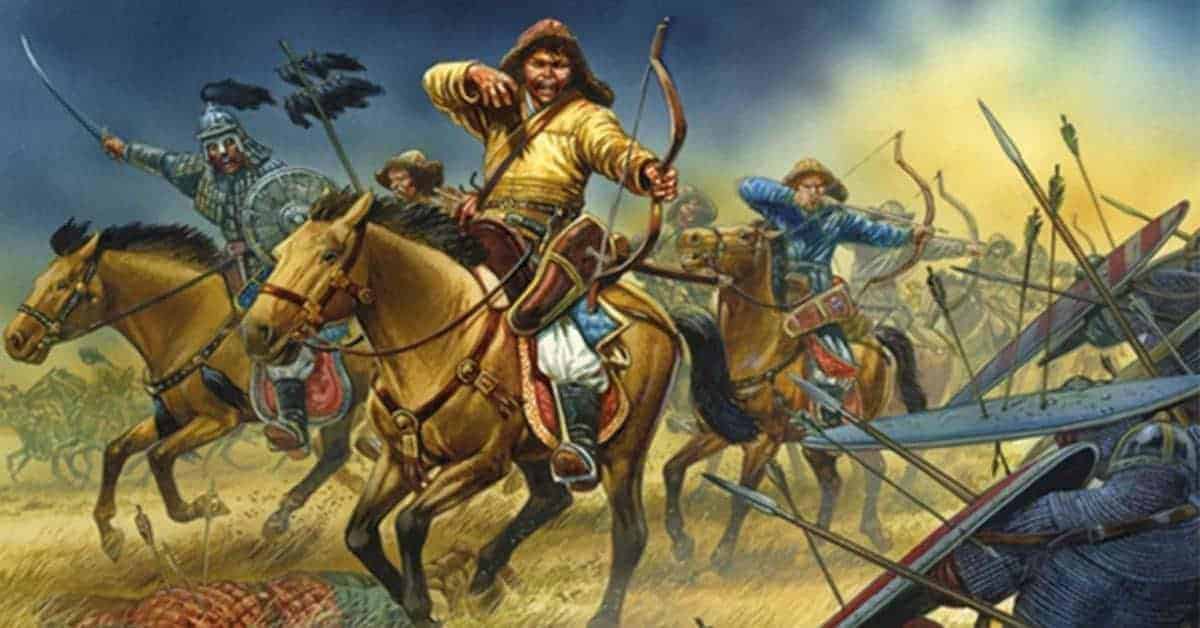Mongols, Huns, Tatars and Turks: some of the nomadic inhabitants of the Eurasian Steppe who, for millennia, terrorized the civilized lands on their periphery with frequent raids, or, when unified under powerful warlords, devastating invasions that could extinguish empires. Steppe nomads had strategic mobility that allowed them to raid settled lands at will, departing with their booty before the locals could mobilize a response, and to choose when, where, and whether to fight the forces sent by the civilized lands to bring them to heel.
Strategic mobility was complemented by three tactical advantages. First, their horses gave them battlefield mobility, making it difficult to force them to fight to the death. If things weren’t going well, the nomads could retreat, living to fight another day.
Second, their preferred weapon, the recurved bow, led to tactical mismatches that afforded a standoff distance from which to kill in relative safety. They could thus attrit less mobile armies with arrows until they were weakened and demoralized, before swooping in to finish them off.
Third, an upbringing in the harsh Steppe, with much of their lives spent on horseback, created a deep pool of hardy warriors. In the settled lands, only a minority could be mobilized as fighters because the majority were needed in the fields and workshops. The Steppe nomads had no fields and little manufacture, while their food source, their animal flocks and herds, could be tended to by children and women. That left nearly the entire adult male population of fighting age available as warriors.

The one saving grace was the difficulty of bringing together the fractious nomads in sufficiently large numbers to overwhelm their civilized neighbors. While small-scale raids on settled lands were a near constant, leaders of Genghis Khan’s or Attila’s caliber, who could realize the Steppe’s full and horrific potential, were few and far in between.

Idanthyrsus
King Idanthyrsus was a 6th century Scythian, a nomadic Iranian speaking tribal confederacy that inhabited the Steppe between the Carpathians and central China, controlled an overland trade network that connected the Greeks, Chinese, Persians, and Indians, and created the first of the Steppe empires that terrified the adjacent settled lands for millennia. Starting in the 7th century BC, the Scythian began raiding into the Middle East, and their first major disruptive role was a leading part in 612 BC in the destruction of the Assyrian Empire, forever extinguishing a nation that had existed for over a millennium and had dominated the Middle East for centuries.
In 513 BC, Darius I of Persia sought to end Scythian raids on his empire by conquering the Scythians. Assembling a huge army, he launched an invasion along the western Black Sea coast, and into today’s southern Ukraine and Russia. The Scythians simply retreated into the vastness of the Steppe, taking their families and herds with them. Avoiding the decisive pitched battle Darius sought, Idanthyrsus laid waste the countryside, blocking wells and destroying pastures, while attriting the invaders with skirmishes and hit and run attacks.
A frustrated Darius challenged Idanthyrsus to stop fleeing and either fight or admit his weakness and submit, recognizing the Persians as his lords. The Scythian’s response, as recorded by Herodotus, highlights the difficulty in bringing turbulent nomads to heel by forcing them to fight if they did not want to: “This is my way, O Persian. I have never fled in fear from any man and I do not flee from you now … We have neither cities nor cultivated land for which we might be willing to fight with you, fearing that they might be taken or ravaged … As for lords, I recognize only my ancestors Zeus and Hestia … As to you calling yourself my lord, I tell thee to ‘Go weep’“.
Darius had to give up and turn back, his invasion amounting to little more than an expensive and fruitless demonstration. Scythians were still raiding the Persian Empire centuries later until its destruction by Alexander the Great and continued to raid the former Persian lands for centuries beyond that.

